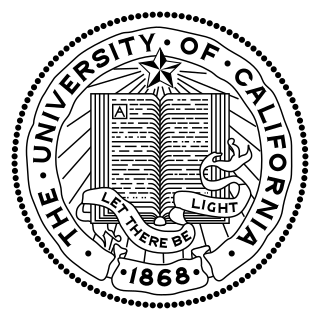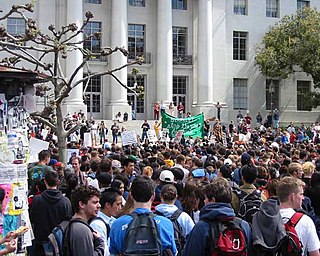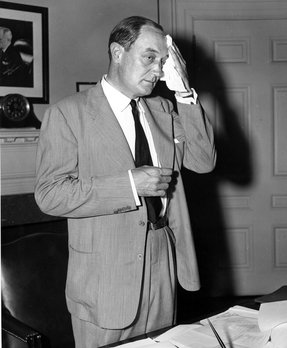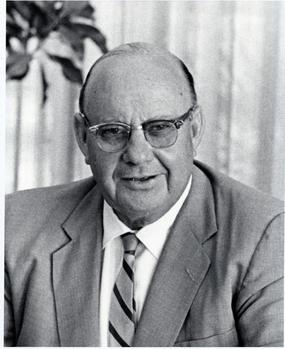
The University of California (UC) is a public land-grant research university system in the U.S. state of California. Headquartered in Oakland, the system is composed of its ten campuses at Berkeley, Davis, Irvine, Los Angeles, Merced, Riverside, San Diego, San Francisco, Santa Barbara, and Santa Cruz, along with numerous research centers and academic abroad centers. The system is the state's land-grant university. Major publications generally rank most UC campuses as being among the best universities in the world. In 1900, UC was one of the founders of the Association of American Universities and since the 1970s seven of its campuses, in addition to Berkeley, have been admitted to the association. Berkeley, Davis, Santa Cruz, Irvine, Los Angeles, Santa Barbara, and San Diego are considered Public Ivies, making California the state with the most universities in the nation to hold the title. UC campuses have large numbers of distinguished faculty in almost every academic discipline, with UC faculty and researchers having won 71 Nobel Prizes as of 2021.

The University of California, Berkeley, is a public land-grant research university in Berkeley, California. It was established in 1868 as the University of California and is the state's first land-grant university and the founding campus of the University of California system. Berkeley is one of the top universities in the world and is one of the leading universities worldwide in producing entrepreneurs and attracting funding for start-up companies. Alumni have founded more companies than any university worldwide and its degrees are among the most valuable in Silicon Valley.

The California State University is a public university system in California, and the largest public university system in the United States. It consists of 23 campuses and 7 off-campus centers, which together enroll 457,992 students and employ 56,256 faculty and staff members. In California, it is one of the three public higher education systems, along with the University of California and the California Community Colleges systems. The CSU system is officially incorporated as The Trustees of the California State University, and is headquartered in Long Beach, California.

Clark Kerr was an American economist and academic administrator. He was the first chancellor of the University of California, Berkeley, and twelfth president of the University of California.

Sproul Plaza is one center of student activity at the University of California, Berkeley. It is divided into two sections: Upper Sproul and Lower Sproul. They are vertically separated by twelve feet (3.7 m) and linked by a set of stairs.

The University House is a residence and venue for official events on the campus of the University of California, Berkeley. Designed by the architect Albert Pissis and completed in 1911, it was formerly named President's House while it served as the home of the president of the University of California, starting with Benjamin Ide Wheeler and ending with Robert Gordon Sproul. Since 1965, it has been the home of the Chancellor of the Berkeley campus.
The Clark Kerr Award, fully the Clark Kerr Award for Distinguished Leadership in Higher Education or the Clark Kerr Medal is an award given to a person who has made "an extraordinary and distinguished contribution to the advancement of higher education." The award is given annually by the Academic Senate of the University of California, Berkeley. The award was established in 1968 as a tribute to the leadership and legacy of Clark Kerr. He was an American professor of economics and academic administrator. He was the first chancellor of the University of California, Berkeley, and twelfth president of the University of California from 1958 to 1967. He played a key role in shaping the University of California system.

Robert Gordon Sproul was the first system-wide president (1952–1958) of the University of California system, and the last president (11th) of the University of California, Berkeley, serving from 1930 to 1952.

The Pacific Coast Conference (PCC) was a college athletic conference in the United States which existed from 1915 to 1959. Though the Pac-12 Conference claims the PCC's history as part of its own, with eight of the ten PCC members now in the Pac-12, the older league had a completely different charter and was disbanded in 1959 due to a major crisis and scandal.
The campus of the University of California, Berkeley, and its surrounding community are home to a number of notable buildings by early 20th-century campus architect John Galen Howard, his peer Bernard Maybeck, and their colleague Julia Morgan. Subsequent tenures as supervising architect held by George W. Kelham and Arthur Brown, Jr. saw the addition of several buildings in neoclassical and other revival styles, while the building boom after World War II introduced modernist buildings by architects such as Vernon DeMars, Joseph Esherick, John Carl Warnecke, Gardner Dailey, Anshen & Allen, and Skidmore, Owings and Merrill. Recent decades have seen additions including the postmodernist Haas School of Business by Charles Willard Moore, Soda Hall by Edward Larrabee Barnes, and the East Asian Library by Tod Williams Billie Tsien Architects.

Edwin Wendell Pauley Sr. was an American businessman and political leader.
The history of the University of California, Riverside, or UCR, started in 1907 when UCR was the University's Citrus Experiment Station. By the 1950s, the University had established a teaching-focused liberal arts curriculum at the site, in the spirit of a small liberal arts college, but California's rapidly growing population made it necessary for the Riverside campus to become a full-fledged general campus of the UC system, and it was so designated in 1959.

Emil Marcel Mrak was an American food scientist, microbiologist, and second chancellor of the University of California, Davis. He was recognized internationally for his work in food preservation and as a world authority on the biology of yeasts.

Daniel Gaskill Aldrich, Jr. was the founding chancellor at the University of California, Irvine from 1962 to 1984. He also served as acting chancellor at the University of California, Santa Barbara from 1986 to 1987 and acting chancellor at the University of California, Riverside from 1984 to 1985.

Martin Meyerson was an American city planner, academic, and president of the University of Pennsylvania from 1970 to 1981. His research, mentorship, essays, and consulting were focused on post-World War II urban policy at the municipal and federal levels.
The history of the University of California, Los Angeles traces back to the 19th century when the institution operated as a teachers' college. It grew in size and scope for nearly four decades on two Los Angeles campuses before California governor William D. Stephens signed a bill into law in 1919 to establish the Southern Branch of the University of California. As the university broke ground for its new Westwood campus in 1927 and dissatisfaction grew for the "Southern Branch" name, the UC Regents formally adopted the "University of California at Los Angeles" name and "U.C.L.A." abbreviation that year. The "at" was removed in 1958 and "UCLA" without periods became the preferred stylization under Chancellor Franklin D. Murphy in the 1960s. In the first century after its founding, UCLA established itself as a leading research university with global impact across arts and culture, education, health care, technology and more.
The history of the University of California, Berkeley begins on October 13, 1849, with the adoption of the Constitution of California, which provided for the creation of a public university. On Charter Day, March 23, 1868, the signing of the Organic Act established the University of California, with the new institution inheriting the land and facilities of the private College of California and the federal funding eligibility of a public agricultural, mining, and mechanical arts college.
The University of California, Santa Barbara (UCSB) traces its roots back to the 19th century, when it emerged from the Santa Barbara School District, which was formed in 1866 and celebrated its 145th anniversary in 2011. UCSB's earliest predecessor was the Anna S. C. Blake Manual Training School, named after Anna S. C. Blake, a sloyd-school which was established in 1891. From there, the school underwent several transformations, most notably its takeover by the University of California system in 1944.

The Free Speech Movement (FSM) was a massive, long-lasting student protest which took place during the 1964–65 academic year on the campus of the University of California, Berkeley. The Movement was informally under the central leadership of Berkeley graduate student Mario Savio. Other student leaders include Jack Weinberg, Michael Rossman, George Barton, Brian Turner, Bettina Aptheker, Steve Weissman, Michael Teal, Art Goldberg, Jackie Goldberg and others.
Edward William Strong was the Chancellor of the University of California at Berkeley between 1961 and 1965. He resigned in March 1965, in large part due to his actions during the Free Speech Movement, which was beginning at that time. Besides his role as chancellor, Strong founded UC Berkeley's Department of Sociology and Social Institutions in 1946, chaired it until 1953, as well as in another of other campus roles.














